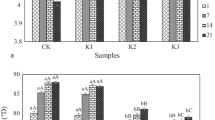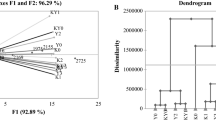Abstract
Water kefir is a plant-based type of kefir and has significant differences from well-known milk kefir. Recently, various complicated substrates were fermented with water kefir grains, but an economical substrate is essential for the industrial aspect. This study aims to understand changes in fermentation products of water kefir grains during fermentation with economic substrates and investigates how fermentation progresses under almost ideal fermentation parameters. The fig-based medium provided high contents of Lactobacillus spp. and Lactococcus spp. Also, fig-based medium with high fructose content contained a higher amount of Bifidobacterium sp. Moreover, the fig-based medium resulted in more organic acid content, forming as much as ten times higher than the sugar-based medium for lactic acid after the same fermentation time (p < 0.05). On the other hand, volatile compounds such as acetaldehyde, ethyl acetate, ethanol, acetic acid, 2-ethyl-1-hexanol, oxime-, methoxy-phenyl, and phenylethyl alcohol were detected for both water kefir samples. Antioxidant capacity (TEAC and ORAC) was higher for the fig-based medium than for the sugar-based medium. This is the first study that comprehensively proved that only sugar solution was not a sufficient medium for water kefir fermentation, but fig containing solution had abundant nutrients to obtain preferable and acceptable water kefir beverage.

Similar content being viewed by others
Data availability
The data that support the findings of this study are available from the corresponding author upon reasonable request.
Abbreviations
- AAB:
-
Acetic acid bacteria
- ABTS + :
-
2,2’-Azinobis (3-ethyl-benzothiazoline-6-sulfonic acid) diammonium salt
- BS:
-
Water kefir with white sugar
- INP:
-
Water kefir with dried figs
- LAB:
-
Lactic acid bacteria
- ORAC:
-
Oxygen radical absorbance capacity
- TEAC:
-
Trolox equivalent antioxidant capacity
References
Kurt TT, Gökırmaklı Ç, Guzel-Seydim ZB (2021) Effects of kefir consumption on carbohydrate profile of mother’s milk. Funct Foods Health Dis 11:473–483
Guzel-Seydim ZB, Gökırmaklı Ç, Greene AK (2021) A comparison of milk kefir and water kefir: physical, chemical, microbiological and functional properties. Trends Food Sci Technol 113:42–53
Gökırmaklı Ç, Güzel-Seydim ZB (2022) Water kefir grains vs. milk kefir grains: physical, microbial and chemical comparison. J Appl Microbiol 132:4349–4358
Moretti AF, Moure MC, Quiñoy F et al (2022) Water kefir, a fermented beverage containing probiotic microorganisms: from ancient and artisanal manufacture to industrialized and regulated commercialization. Future Foods 5:100123
Tan LL, Ngiam JJ, Sim ESZ et al (2022) Liquorilactobacillus satsumensis from water kefir yields α-glucan polysaccharides with prebiotic and synbiotic qualities. Carbohydr Polym 290:119515
Azi F, Tu C, Meng L et al (2021) Metabolite dynamics and phytochemistry of a soy whey-based beverage bio-transformed by water kefir consortium. Food Chem 342:128225
Dwiloka B, Rizqiati H, Setiani BE (2020) Physicochemical and sensory characteristics of green coconut (Cocos nucifera L.) water kefir. Int J Food Stud 9:346–359
Fiorda FA, de Melo Pereira GV, Thomaz-Soccol V et al (2017) Microbiological, biochemical, and functional aspects of sugary kefir fermentation-a review. Food Microbiol 66:86–95
Gulitz A, Stadie J, Wenning M et al (2011) The microbial diversity of water kefir. Int J Food Microbiol 151:284–288
Ozcelik F, Akan E, Kinik O (2021) Use of Cornelian cherry, hawthorn, red plum, roseship and pomegranate juices in the production of water kefir beverages. Food Biosci 42:101219
Randazzo W, Corona O, Guarcello R et al (2016) Development of new non-dairy beverages from Mediterranean fruit juices fermented with water kefir microorganisms. Food Microbiol 54:40–51
Corona O, Randazzo W, Miceli A et al (2016) Characterization of kefir-like beverages produced from vegetable juices. LWT-Food Sci Technol 66:572–581
Silva MR, Santos FL, Nunes IL (2018) Production of rice cereal-based Kefir beverage. Afr J Biotechnol 17:322–327
Priscilla V, Pantjajani T, Irawati F (2020) Kefir Susu Nabati dengan Penambahan Kulit Pisang Tanduk (Musa Paradisiacal Var. Corniculata). KELUWIH J Sains Dan Teknol 1:15–28
Azi F, Tu C, Rasheed HA, Dong M (2020) Comparative study of the phenolics, antioxidant and metagenomic composition of novel soy whey-based beverages produced using three different water kefir microbiota. Int J Food Sci Technol 55:1689–1697
Tu C, Azi F, Huang J et al (2019) Quality and metagenomic evaluation of a novel functional beverage produced from soy whey using water kefir grains. Lwt 113:108258
Nascimento RQ, Deamici KM, Tavares PPLG et al (2022) Improving water kefir nutritional quality via addition of viable Spirulina biomass. Bioresour Technol Rep 17:100914
Spencer JF, de Spencer ALR (2008) Food microbiology protocols. Springer Science & Business Media, Berlin
Re R, Pellegrini N, Proteggente A et al (1999) Antioxidant activity applying an improved ABTS radical cation decolorization assay. Free Radic Biol Med 26:1231–1237
Dávalos A, Bartolomé B, Gómez-Cordovés C (2005) Antioxidant properties of commercial grape juices and vinegars. Food Chem 93:325–330
Singh S, Singh RP (2008) In vitro methods of assay of antioxidants: an overview. Food Rev Int 24:392–415
Laureys D, Aerts M, Vandamme P, De Vuyst L (2018) Oxygen and diverse nutrients influence the water kefir fermentation process. Food Microbiol 73:351–361
Laureys D, Van Jean A, Dumont J, De Vuyst L (2017) Investigation of the instability and low water kefir grain growth during an industrial water kefir fermentation process. Appl Microbiol Biotechnol 101:2811–2819
Hampton J, Tang C, Jayasree Subhash A, Serventi L (2021) Assessment of pear juice and puree as a fermentation matrix for water kefir. J Food Process Preserv 45:e15223
Zongo O, Cruvellier N, Leray F et al (2020) Physicochemical composition and fermentation kinetics of a novel Palm Sap-based Kefir beverage from the fermentation of Borassus aethiopum Mart. fresh sap with kefir grains and ferments. Sci Afr 10:e00631
Maldonado RR, Pedreira AJRM, Cristianini LB et al (2020) Application of soluble fibres in the osmotic dehydration of pineapples and reuse of effluent in a beverage fermented by water kefir. Lwt 132:109819
Gamba RR, Yamamoto S, Sasaki T et al (2019) Microbiological and functional characterization of kefir grown in different sugar solutions. Food Sci Technol Res 25:303–312
Fiorda FA, de Melo Pereira GV, Thomaz-Soccol V et al (2016) Development of kefir-based probiotic beverages with DNA protection and antioxidant activities using soybean hydrolyzed extract, colostrum and honey. LWT-Food Sci Technol 68:690–697
Magalhaes KT, de M.Pereira GV, Dias DR, Schwan RF (2010) Microbial communities and chemical changes during fermentation of sugary Brazilian kefir. World J Microbiol Biotechnol 26:1241–1250
Koh WY, Utra U, Ahmad R et al (2018) Evaluation of probiotic potential and anti-hyperglycemic properties of a novel Lactobacillus strain isolated from water kefir grains. Food Sci Biotechnol 27:1369–1376
Thakkar U, Preetha R, Nithyalakshmi V (2018) Evaluation of viability of Lactobacillus bulgaricus in symbiotic microcapsules: before and after freeze drying. Int Food Res J 25:1642–1646
Nguyen BT, Bujna E, Fekete N et al (2019) Probiotic beverage from pineapple juice fermented with Lactobacillus and Bifidobacterium strains. Front Nutr 6:54
Hsieh H-H, Wang S-Y, Chen T-L et al (2012) Effects of cow’s and goat’s milk as fermentation media on the microbial ecology of sugary kefir grains. Int J Food Microbiol 157:73–81
Laureys D, De Vuyst L (2014) Microbial species diversity, community dynamics, and metabolite kinetics of water kefir fermentation. Appl Environ Microbiol 80:2564–2572
Bueno RS, Ressutte JB, Hata NN et al (2021) Quality and shelf life assessment of a new beverage produced from water kefir grains and red pitaya. Lwt 140:110770
Destro TM, Prates DDF, Watanabe LS et al (2019) Organic brown sugar and jaboticaba pulp influence on water kefir fermentation. Ciência E Agrotecnologia 43:e005619
Verce M, De Vuyst L, Weckx S (2019) Shotgun metagenomics of a water kefir fermentation ecosystem reveals a novel Oenococcus species. Front Microbiol 10:479
Laureys D, Aerts M, Vandamme P, De Vuyst L (2019) The buffer capacity and calcium concentration of water influence the microbial species diversity, grain growth, and metabolite production during water kefir fermentation. Front Microbiol 10:2876
Slatnar A, Klancar U, Stampar F, Veberic R (2011) Effect of drying of figs (Ficus carica L.) on the contents of sugars, organic acids, and phenolic compounds. J Agric Food Chem 59:11696–11702
Pande G, Akoh CC (2010) Organic acids, antioxidant capacity, phenolic content and lipid characterisation of Georgia-grown underutilized fruit crops. Food Chem 120:1067–1075
Darvishzadeh P, Orsat V, Martinez JL (2021) Process optimization for development of a novel water kefir drink with high antioxidant activity and potential probiotic properties from Russian olive fruit (Elaeagnus angustifolia). Food Bioprocess Technol 14:248–260
Alsayadi MSM, Al-jawfi Y, Belarbi M, Sabri FZ (2013) Antioxidant potency of water kefir. J Microbiol Biotechnol Food Sci 2:2444–2447
Rabl W, Liniger B, Sutter K, Sigrist T (1994) Ethanol content of Kefir water. Blutalkohol 32:76–79
Laureys D, Leroy F, Hauffman T et al (2021) The type and concentration of inoculum and substrate as well as the presence of oxygen impact the water kefir fermentation process. Front Microbiol 12:628599
McGinty D, Scognamiglio J, Letizia CS, Api AM (2010) Fragrance material review on 2-ethyl-1-hexanol. Food Chem Toxicol 48:S115–S129
Farag MA, Jomaa SA, Abd El-Wahed A, El-Seedi HR (2020) The many faces of kefir fermented dairy products: Quality characteristics, flavour chemistry, nutritional value, health benefits, and safety. Nutrients 12:346
Xu D, Wang W, Wang P et al (2021) Soy whey as a promising substrate in the fermentation of soy sauce: a study of microbial community and volatile compounds. Int J Food Sci Technol 56:5799–5811
Acknowledgements
We would like to thank Danem Inc. (www.kefirdanem.com) for providing kefir grains and technical assistance.
Funding
This study was supported by Suleyman Demirel University Scientific Research Projects Coordination Unit (Project FDK-2020-7481). Çağlar Gökırmaklı was supported via a doctorate fellowship of The Council of Higher Education (YÖK 100/2000) during his Ph.D. program.
Author information
Authors and Affiliations
Contributions
ÇG: conceptualization, methodology, data curation, funding acquisition, writing—original draft preparation, YKY: methodology, writing—original draft preparation, ZBGS: conceptualization, methodology, funding acquisition, writing— original draft preparation, supervision.
Corresponding author
Ethics declarations
Conflict of interest
The authors declare that there is no conflict of interest.
Compliance with ethical requirements
The authors declare this study complies with all ethical requirements.
Additional information
Publisher's Note
Springer Nature remains neutral with regard to jurisdictional claims in published maps and institutional affiliations.
Rights and permissions
Springer Nature or its licensor (e.g. a society or other partner) holds exclusive rights to this article under a publishing agreement with the author(s) or other rightsholder(s); author self-archiving of the accepted manuscript version of this article is solely governed by the terms of such publishing agreement and applicable law.
About this article
Cite this article
Gökırmaklı, Ç., Yüceer, Y.K. & Guzel-Seydim, Z.B. Chemical, microbial, and volatile changes of water kefir during fermentation with economic substrates. Eur Food Res Technol 249, 1717–1728 (2023). https://doi.org/10.1007/s00217-023-04242-9
Received:
Revised:
Accepted:
Published:
Issue Date:
DOI: https://doi.org/10.1007/s00217-023-04242-9




